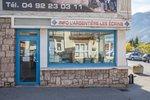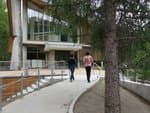
Rortie Bleue (trail route no. 7)
“Of course, the main things you remember from this itinerary might be its impressive sections on the ridge or past the limestone cliffs, but the rustic descent below the hamlet of Les Roberts is one of the loveliest you'll see, not to mention the stretch along the Biaysse. All these contrasts make it really fascinating.” Marie-Geneviève Nicolas, park ranger at the Parc National des Écrins
Description
From the Valley Centre ("Maison de la Vallée"), head down into the meadow to cross the Biaysse and follow the track along the right-hand bank of the river.
- Two bridges further down, cross back over the Biaysse and go right along the road for 50 metres until you come to another track on the left. This crosses a bridge over a stream and leads to the bottom of the path to the Col de l'Aiguille. Head up this path towards the Col de l'Aiguille, and then towards Le Clot du Puy. The path offers some beautiful vantage points and takes you down steep little paths among the rocks, then it runs along ridges in the forest.
- In Le Clot du Puy, head downhill towards Freissinières, Coste du Plan. Lower down, be sure to follow the signs for trail no. 7
- The path leads to the road, which you follow right for a short distance until you come to the hamlet of Les Roberts.
- Just after the waste bins, take the narrow lane leading down at an angle to the left. The old track runs down below the hamlet and then crosses the road twice before coming to Freissinières. Go past the church of Sainte-Marie-Madeleine and after 50 metres turn right to make your way back to your starting point.
- Departure : Valley Centre ("Maison de la Vallée"), Freissinières
- Arrival : Valley Centre ("Maison de la Vallée"), Freissinières
- Towns crossed : Freissinières
Altimetric profile
Recommandations
Follow and apply the internal rules of the Bike Park (displayed at the entrance
Before setting off, it is very important to check the opening periods for this route on the website: https://stationdetrail.com/fr/stations/le-pays-des-ecrins/parcours
Share your photographs on social networks with #stationdetrailecrins
Check weather conditions before setting off.
Rescue services contact details: Secours Montagne (Mountain Rescue): +33 (0)4 92 22 22 22 or 112
Show consideration for the work of farmers, livestock keepers and owners
Close all gates behind you
Take your litter home
Do not take shortcuts across pastureland
The trail routes are also suitable for walking
Information desks
23 Avenue de la République, 05120 L'Argentière-La Bessée
Vallouise Park house
, 05290 Vallouise
Information, documentation, models, exhibitions, screenings, product sales and works of the Park. Guided tours for school, reservation required. The new Park House opened in Vallouise since June 1, and offers visitors an interactive permanent exhibition inviting to explore the area and its heritage. A temporary exhibition space will allow a renewed offer. Finally, the device is completed by an audiovisual room to organize screenings and conferences Free admission. All animations of the Park are free unless otherwise stated.
Transport
Public transport >> www.pacamobilite.fr
Consider car-sharing >> www.blablacar.fr
For more information, ask at the Tourist Information Office nearest to the trail starting point.
Access and parking
11.5 km from L'Argentière-La Bessée, take the N94 and then the D38.
Sensitive areas
Peregrine falcon
- Impacted practices:
- Aerial, Vertical
- Sensitivity periods:
- FebMarAprMayJun
- Contact:
- Parc National des Écrins
Julien Charron
julien.charron@ecrins-parcnational.fr
15 points of interest

Épine-vinette en fleurs - Mireille Coulon - Parc national des Écrins  Flora
FloraThe common barberry
The common barberry is a bush with long thorns arranged in threes, and with oval serrated leaves. In spring, it produces clusters of yellow flowers, which later develop into red, oval and elongated berries. These tart fruits are edible and can be made into jellies... if you have the patience to gather them! This shrub grows almost everywhere.

La vallée de Freissinières - Office de tourisme Pays des Écrins  History
HistoryThe Freissinières valley
The valley was created as the result of glacial overdeepening, that is to say, when the glacier came to a halt against the Pallon hard rock bar, it created a depression. When the glaciers retreated, a lake was left behind this rock bar and was gradually filled up by alluvial deposits. From a historical point of view, the Protestant pastor Félix Neff fundamentally altered life in the valley in 1826 by founding a training college for primary school teachers, developing irrigation processes and teaching new crop growing methods, among other things…

Goodyère rampante - Marie-Geneviève Nicolas - Parc national des Écrins  Flora
FloraThe creeping lady’s-tress
This inconspicuous little orchid grows on moss, in the undergrowth of the pine forest. Growing at the base of the stem, its leaves are oval and pointed, with a network of veins. The upright stem only bears a few scales. Covered in a fine down, the white flowers are arranged in the form of a spiral spike, facing the same way. A little gem that is worth keeping an eye out for!

Un sapin pectiné - Mireille Coulon - Parc national des Écrins  Flora
FloraThe European silver fir
The fir thrives on this north-exposed slope, called the ubac. Its needles have two white stripes on their undersides. They are arranged on either side of the boughs, and not all the way around them, which distinguishes it from the spruce. The elongated cones stand upright, rather than hanging downwards. They grow in large number, often mingling with larch trees under whose shade they can grow. By contrast, the larch - the "tree of light" - cannot grow under the cover of fir trees.

Un campagnol amphibie - Damien Combrisson - Parc national des Écrins  Fauna
FaunaThe southern water vole
Flattened paths through the reeds, and holes 6 to 7 cm in diameter... the southern water vole has been here! This large rodent with dark brown fur on its back digs its burrow in the banks of the stream. This species, which lives close to water, causes no damage to crops. Not a prolific breeder, its numbers are low and it is threatened with extinction.

Aiguilles de pin sylvestre - Christian Baïsset - Parc national des Écrins  Fauna
FaunaThe black pine
The black pine did not arrive here of its own accord. It was introduced by the National Forestry Agency and was planted to stabilise eroded mountain areas. It can be identified by its long needles which are grouped in pairs and by its large cones.

Raisin d'ours, Ericacées - Cédric Dentan - Parc national des Écrins  Flora
FloraThe bearberry
The floor of the pine forest is carpeted by a creeping sub-shrub with glossy oval evergreen leaves. In spring, the bearberry produces small bell-shaped flowers which are white and edged with pink. They will turn into red berries, edible but floury. Bears love them, hence their name. It is a drought-tolerant plant.

Hirondelle de rocher - Mireille Coulon - Parc national des Écrins  Fauna
FaunaThe crag martin
The birds that are constantly swooping around the cliff are crag martins. They are brown with a beige underside. They have built their nests under small overhangs. This species is very common in the Alps. Partially migratory, crag martins return to the Mediterranean coast in winter, where they join resident populations. So it is the first bird to reappear in the valleys of the Pays des Écrins in late February and the last to leave in October!

Le lys orangé - Marie-Geneviève Nicolas - Parc national des Écrins  Flora
FloraThe fire lily
In June and early July, the rocks are brightened up here and there by large orange flowers: the fire lily is a splendid plant which grows in the mountains of Europe. It grows in rocky or bush-covered terrain and even - why not? - right on the cliff faces, in dry areas. It is a protected species.

Grotte des Vaudois - Thierry Maillet - Parc national des Écrins  History
HistoryThe Grotte des Vaudois - The Waldensians' Cave
The history of Freissinières is linked to that of the Waldensians, who found refuge in this valley and in other Alpine valleys in the thirteenth century. The followers of this religious movement - which later embraced the reformation - were deemed to be heretics and therefore persecuted. This cave, in which Waldensians sought refuge after being taken by surprise, witnessed massacres perpetrated by the Inquisition.

Le flambé - Blandine Delenatte - Parc national des Écrins  Fauna
FaunaThe scarce swallowtail
A large pale yellow butterfly with black stripes flutters from bush to bush. There is a "tail" at the tips of the posterior wings, marked with an orange and blue blotch. The scarce swallowtail lives in hot, dry environments. It favours uncultivated land where blackthorn and hawthorn grow, on which the female lays her eggs and where the caterpillars develop.

Le rougequeue à front blanc - Damien Combrisson - Parc national des Écrins  Fauna
FaunaThe common redstart
The common redstart can be told apart from its cousin, the black redstart by its white eyebrow (hence its French name which is translated as "white-browed redstart") and its orange breast. At least for the male, since the female of both birds is duller and brownish, but the female common redstart also has an orangey tail. It returns from Africa in early April and searches the areas to find a hollow in a tree or in an old wall where it builds its nest.

La maison de Felix Neff - Manuel Meester - Parc national des Écrins  History
HistoryFélix Neff
Félix Neff was a Swiss Protestant pastor. He was responsible for the Protestant Revival in the Freissinières valley in the seventeenth century. He also set up the first education college for primary school teachers in France, in Dormillouse in 1826. He was also behind new irrigation and house-building techniques, developments which improved the everyday lives of the local people.

L'église Sainte Marie-Madeleine - Office de tourisme Pays des Écrins  Vernacular heritage
Vernacular heritageThe church of Sainte Marie-Madeleine
The church of Sainte Marie-Madeleine was built in the seventeenth century. It is thought to be a former Protestant church which escaped destruction in 1684 when Louis XIV was leading an anti-Protestant drive. The Protestant church is then thought to have undergone works to convert it into a Catholic church.

Freissinières - Office de tourisme Pays des Écrins  History
HistoryFreissinières
The name Freissinières comes from the old word freissinière meaning "black ash". This municipality, which extends as far as the Col des Terres Blanches and the Col de Freissinières, both of which overlook the Champsaur valley, is made up of thirteen hamlets, although none of them are called Freissinières! Archaeological excavations carried out twenty years ago show that sites at high altitude (such as Faravel) were occupied on a seasonal basis from the retreat of the glaciers 12,000 years ago (Upper Palaeolithic period) and that this occupation continued after that.
Source

Report a problem or an error
If you have found an error on this page or if you have noticed any problems during your hike, please report them to us here:


